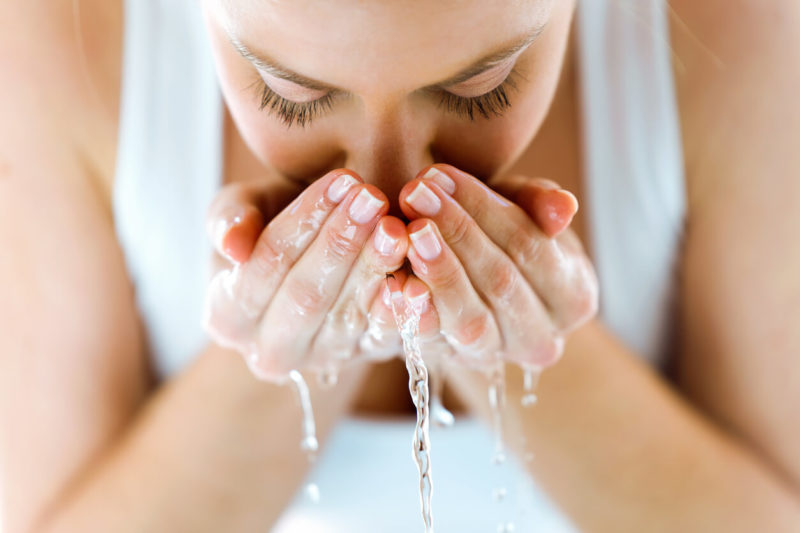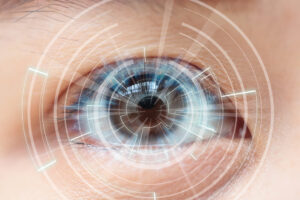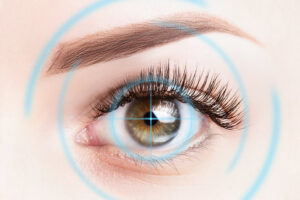
Have you noticed a sign by the first aid kit at work or in the break room about how to flush your eye? If you work in an environment where chemicals are used, there may also be an eye flushing station.
Regardless of where you work, knowing how to flush your eye is an important part of first aid. You don’t need to have an actual eye flush kit at home (although it’s not a bad idea if you have young children), but knowing the steps is important because at some point, everyone gets something in their eye that shouldn’t be there!
Ideally, An Eye Flush Begins With Removing Contact Lenses
If you or someone near you gets splashed by a chemical or gets dirt or dust blown into his or her eye that tears won’t wash out, the first thing to do is remove contact lenses if possible. Contact lenses can trap debris, particularly if the person has already rubbed the affected eye.
If you can, wash your hands and remove your own lens. If you’re with a person who can’t remove his/hers lens, you can try to do it for him. First, wash your hands and slip on medical exam gloves, if they’re available at your worksite. Gently touch the tip of the lower part of the lens, slide it down the eye, and lightly pinch (we can’t overemphasize this part!) the lens as it slides off the eye.
But sometimes, it’s just not possible to remove a lens. Don’t spend more than a minute or two trying. The eye may be squeezed shut, the affected person may be too agitated to remain still, or there’s just too much dryness to move the lens.
Positioning and Applying an Eye Flush
Before flushing the eye, tilt the head down so that the affected eye is lowest. This keeps debris, particularly liquids, from further spreading into the eye.
Use gentle but steady pressure to get the eye flush solution or clean, lukewarm water across the eye.
- Keep the eye open as much as possible
- Look up, down, and side to side as the flush continues
- Flush for at least ten minutes for nontoxic debris.
That last part sounds excessive, but it’s really necessary to get as much of the debris out as possible. It’s a good idea to keep a clean towel handy, or at least cover the person with a clean, unused trash bag because there will be a lot of water!
If there has been a chemical splash, get someone contact emergency services while you’re preparing for an eye flush. Start it right away — don’t wait for them. A chemical splash includes household cleaners. In this situation, continue flushing the eye until paramedics arrive. Even if the person feels OK after 15 minutes of flushing, don’t cancel the call — a chemical eye splash needs medical attention right away.
When Not to Flush an Eye
While it’s very important to know how to flush your eye, it’s also key to recognize when an eye flush will make a situation worse.
Don’t start an eye flush when the object has penetrated the eyeball or the eye has been cut. This obviously means immediate medical attention, but, in the meantime, cover the affected eye with gauze or even a cup — it needs to be protected from further intrusion and contamination including rubbing painful, swollen eyes.
Also, don’t flush an eye that’s been subject to an impact. The pressure can cause more damage. Instead, gently apply a soft, cold compress to reduce swelling and pain. Get medical attention: eyes are delicate and even a seemingly minor injury can be serious.
Visit our website for more information about eye health and safety or contact our Manhattan Eye Center.
Contact Us
If you have more questions about LASIK procedures, get in touch with us.
Related Blogs

Timing is Everything: When to Consider LASIK After Nursing for Optimal Results
Timing is everything when considering LASIK eye surgery after nursing, and understanding the optimal period for this procedure is vital for both mother and baby.

Cataract Surgery: Restoring Clarity and Confidence
Cataract surgery is a transformative procedure that offers a new lease on clear vision and renewed confidence. As cataracts cloud the eye’s lens, causing blurred

Intralase LASIK Explained: What to Expect Before, During, and After the Procedure
Intralase LASIK is a cutting-edge procedure that offers a safe, effective, and precise way to enhance vision compared to traditional LASIK methods. Understanding what to
